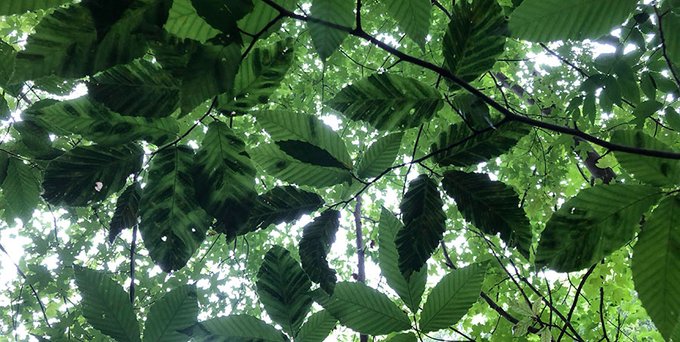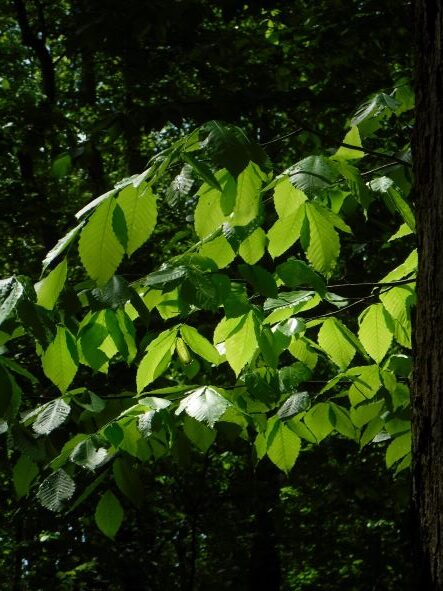As we know, beech leaf disease (BLD) has spread rapidly in the decade since its discovery in northeast Ohio. It has been detected as far east as the Maine coast, as far south as northern Virginia, as far north as southern Ontario, and as far west as eastern Michigan and northern Indiana. It has been found in 12 states.
BLD is associated with a nematode, Litylenchus crenatae subsp. mccannii (Lcm), although whether this is the sole causal agent is not yet clear.
BLD’s North American host, American beech (Fagus grandifolia),is an important native deciduous hardwood species. It plays important roles in nutrient cycling, erosion control, and carbon storage and sequestration in forests. Wildlife species depend on the trees’ canopies and especially cavities blog for nesting sites, shelter, and nutritious nuts. American beech – with sugar maple (Acer saccharum) and yellow birch (Betula alleghaniensis) – dominate the northern hardwood ecosystem of northeastern United States and southeastern Canada. These forests occupy a huge area; in just New England and New York they occupy 20 million acres (Leak, Yamasaki and Holleran. 2014; full citation at end of blog).
Beech leaf disease also affects European beech, (F. sylvatica), Chinese beech (F. engleriana), and Oriental beech (F. orientalis) planted in North America. The disease has not yet been detected in Asia or Europe. Japanese beech (F. crenata) sporadically display symptomatic leaves, but the disease has not been reported there.
Scientists working to understand the disease, how it spreads, and its ecological impact confer every other month. The next time is in early December.
Paulo Vieira, of the USDA Agriculture Research Service, leads one group seeking to better understand how the disease infects its host. They published a new study (see full citation at end of blog) examining how the nematode provokes changes in the cells of the trees’ leaves. As they point out, leaves are plants’ primary organs for photosynthesis – hence providing energy for growth. The leaf is composed of a several cell types organized into different tissues with specific function related to photosynthesis, gas exchange, and/or the transportation of water and nutrients. Thus, changes in leaf morphology affect the normal functioning of the leaf and therefore the tree’s growth and survival.
Vieira et al. found that:
- The BLD nematode enters the leaf bud as it forms in late summer. In early autumn, all nematode developmental stages were found in the buds, including eggs at various stages of embryonic development, juveniles, and adults. Adult males were found in fewer than 20% of the buds, suggesting that the nematode can reproduce asexually.
- Feeding by the BLD nematode induces abnormal and extensive cell proliferation, resulting in a significant increase of the number of cell layers inside the leaf. These changes improve the nutrition that the leaves provide to the nematode. However, the BLD-induced distortions of the bud persist as the leaf grows. Symptomatic leaf “banding” results. These areas have a proliferation of abnormally large and irregularly shaped cells with more chloroplasts. Intercellular spaces are also larger; this is where the nematodes are found. in. (The publication has dramatic photographs.)
- Sites damaged by nematodes are a major resource for metabolites needed for plant performance. So their damage imposes a considerable drain.
- Colonization of roots by ectomycorrhizal fungal is also reduced in severely diseased trees.
- Immature female nematodes are the principal winter survivors. However, many die, making it difficult to culture nematodes in the spring. The nematodes reproduce during the growing season. Buildup of nematode numbers makes culturing easier, so facilitating confirmation of the disease’s presence.
- Nematodes can migrate along the stem to other leaves, thus spreading the infection.
Vieira et al. tell us fascinating facts about the nematode. The BLD nematode, Litylenchus crenatae subsp. mccannii (Lcm) is now considered one of the top ten most important plant-parasitic nematodes in the United States. To date, species of this genus have been found only in Japan and New Zealand. The species L. crenatae was first described from Japan. A second species — L. coprosma – was detected in 2012 in New Zealand in association with small chlorotic patches on leaves of two native plants in the Coprosma genus.
Litylenchus belongs to the family Anguinidae. Several species in the family are designated quarantine pests because they cause economically significant damage to food and ornamental corps, including grains (wheat, barley, rice) and potatoes. Anguinidae nematodes often parasitize aerial parts of the hosts (e.g., leaves, stems, inflorescences, seeds); less frequently they infest roots. They can migrate along the host tissue surfaces in water films. Their host ranges vary from broad to narrow. Other Anguinidae nematodes apparently share the ability to manipulate the host’s cellular machinery, which often results in the induction of cell hyperplasia [the enlargement of an organ or tissue caused by an increase in the reproduction rate of its cells], and hypertrophy [increase and growth of cells] of the tissues on which they feed.
Vieira et al. assert that the rapid spread of Litylenchus crenatae subsp. mccannii – combined with the apparent lack of resistance in native beech trees – suggests that this nematode was recently introduced to North America. Furthermore, the ability of this subspecies to change the host’s cell cycle machinery supports the link between the presence of the nematode and the disease.
The mechanisms by which nematodes change host-plant cells are unknown. I hope that scientists will pursue these questions. Perhaps the nematode family’s threat to grains and other food crops will prompt funding for such work. Unfortunately, I don’t think the threat to an ecologically-important native tree species will have the same power.
SOURCES
Leak, W.B, M. Yamasaki and R. Holleran. 2014 Silvicultural Guide for Northern Hardwoods in the Northeast. United States Department of Ariculture Forest Service Northern Research Station. General Technical Report NRS-132. April 2014.
Vieira P, M.R. Kantor MR, A. Jansen, Z.A. Handoo, J.D. Eisenback. (2023) Cellular insights of beech leaf disease reveal abnormal ectopic cell division of symptomatic interveinal leaf areas. PLoS ONE October 5, 2023. 18(10) https://doi.org/10.1371/pone.0292588
Posted by Faith Campbell
We welcome comments that supplement or correct factual information, suggest new approaches, or promote thoughtful consideration. We post comments that disagree with us — but not those we judge to be not civil or inflammatory.
For a detailed discussion of the policies and practices that have allowed these pests to enter and spread – and that do not promote effective restoration strategies – review the Fading Forests report at http://treeimprovement.utk.edu/FadingForests.htm
or

